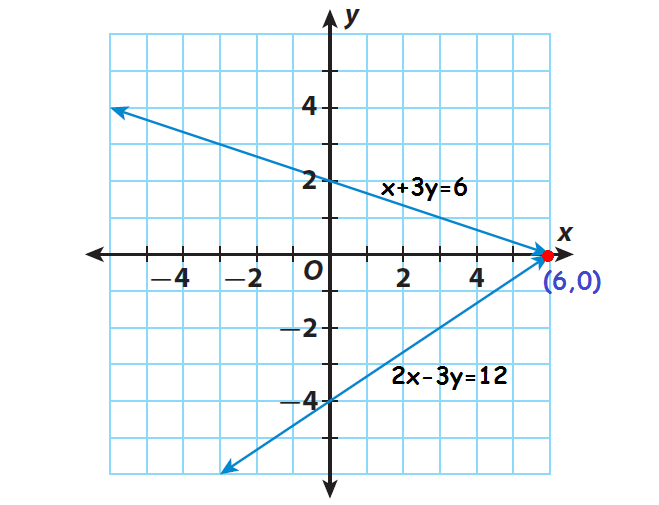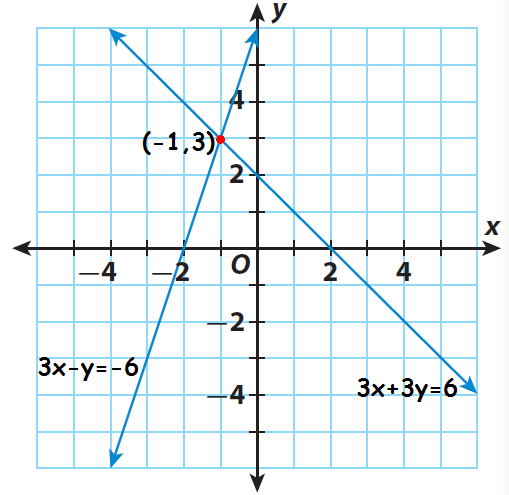SOLVING LINEAR SYSTEMS BY ADDING OR SUBTRACTING WORKSHEET
Subscribe to our ▶️ YouTube channel 🔴 for the latest videos, updates, and tips.
Problem 1 :
Solve the system of equations by adding. Check your the solution by graphing.
2x - 3y = 12
x + 3y = 6
Problem 2 :
Solve the system of equations by subtracting. Check the solution by graphing.
3x + 3y = 6
3x - y = - 6
Problem 3 :
Sum of the cost price of two products is $50. Sum of the selling price of the same two products is $52. If one is sold at 20% profit and other one is sold at 20% loss, find the cost price of each product.

Detailed Answer Key
Problem 1 :
Solve the system of equations by adding. Check your the solution by graphing.
2x - 3y = 12
x + 3y = 6
Answer :
Step 1 :
In the given two equations, the variable y is having the same coefficient (3). And also, the variable y is having different signs.
So we can eliminate the variable y by adding the two equations.

Step 2 :
Solver the resulting equation for the variable x.
3x = 18
Divide both sides by 3.
3x / 3 = 18 / 3
x = 6
Step 3 :
Substitute the value of x in the second equation to solve for y.
6 + 3y = 6
Subtract 6 from both sides.
3y = 0
Divide both sides by 3.
y = 0
Step 3 :
Write the solution as ordered pair as (x, y).
(6, 0)
Step 4 :
Check the solution by graphing.
To graph the equations, write them in slope-intercept form.
That is,
y = mx + b
2x - 3y = 12
y = (2/3)x - 4
Slope = 2/3
y-intercept = -4
x + 3y = 6
y = -(1/3)x + 2
Slope = -1/3
y-intercept = 2

The point of intersection is (6, 0).
Problem 2 :
Solve the system of equations by subtracting. Check the solution by graphing.
3x + 3y = 6
3x - y = - 6
Solution :
Step 1 :
In the given two equations, the variable x is having the same coefficient (3), And also, the variable x is having the same sign in both the equations.
So we can eliminate the variable x by subtracting the two equations.
(3x + 3y) - (3x - y) = (6) - (-6)
3x + 3y - 3x + y = 6 + 6
Simplify.
4y = 12
Divide both sides by 4.
4y / 4 = 12 / 4
y = 3
Step 2 :
Plug y = 3 in one of the equations.
3x - y = - 6
3x - 3 = - 6
Add 3 to both sides.
(3x - 3) + 3 = (-6) + 3
3x - 3 + 3 = -6 + 3
Simplify.
3x = -3
Divide both sides by 3
3x / 3 = -3 / 3
x = - 1
Step 3 :
Write the solution as ordered pair as (x, y).
(-1, 3)
Step 4 :
Check the solution by graphing.
To graph the equations, write them in slope-intercept form.
That is,
y = mx + b
3x + 3y = 6
y = - x + 2
Slope = - 1
y-intercept = 2
3x - y = - 6
y = 3x + 6
Slope = 3
y-intercept = 6

The point of intersection is (-1, 3).
Problem 3 :
Sum of the cost price of two products is $50. Sum of the selling price of the same two products is $52. If one is sold at 20% profit and other one is sold at 20% loss, find the cost price of each product.
Solution :
Step 1 :
Let x and y be the cost prices of two products.
Then,
x + y = 50 -----(1)
Step 2 :
Let us assume that x is sold at 20% profit
Then, the selling price of x is 120% of x.
Selling price of x = 1.2x
Let us assume that y is sold at 20% loss
Then, the selling price of y is 80% of y.
Selling price of y = 0.8y
Given : Selling price of x + Selling price of y = 52
1.2x + 0.8y = 52
To avoid decimal, multiply both sides by 10
12x + 8y = 520
Divide both sides by 4.
3x + 2y = 130 -----(2)
Step 3 :
Eliminate one of the variables to get the value of the other variable.
In (1) and (2), both the variables x and y are not having the same coefficient.
One of the variables must have the same coefficient.
So multiply both sides of (1) by 2 to make the coefficients of y same in both the equations.
(1) ⋅ 2 -----> 2x + 2y = 100 -----(3)
Variable y is having the same sign in both (2) and (3).
To change the sign of y in (3), multiply both sides of (3) by negative sign.
- (2x + 2y) = - 100
- 2x - 2y = - 100 -----(4)
Step 4 :
Now, eliminate the variable y in (2) and (4) as given below and find the value of x.

Step 5 :
Substitute x = 30 in (1) to get the value of y.
(2)-----> 30 + y = 50
Subtract 30 from both sides.
y = 20
So, the cost prices of two products are $30 and $20.
Subscribe to our ▶️ YouTube channel 🔴 for the latest videos, updates, and tips.
Kindly mail your feedback to v4formath@gmail.com
We always appreciate your feedback.
About Us | Contact Us | Privacy Policy
©All rights reserved. onlinemath4all.com

Recent Articles
-
10 Hard SAT Math Questions (Part - 45)
Jan 19, 26 06:14 AM
10 Hard SAT Math Questions (Part - 45) -
10 Hard SAT Math Questions (Part - 44)
Jan 12, 26 06:35 AM
10 Hard SAT Math Questions (Part - 44) -
US Common Core K-12 Curricum Algebra Solving Simple Equations
Jan 07, 26 01:53 PM
US Common Core K-12 Curricum Algebra Solving Simple Equations
